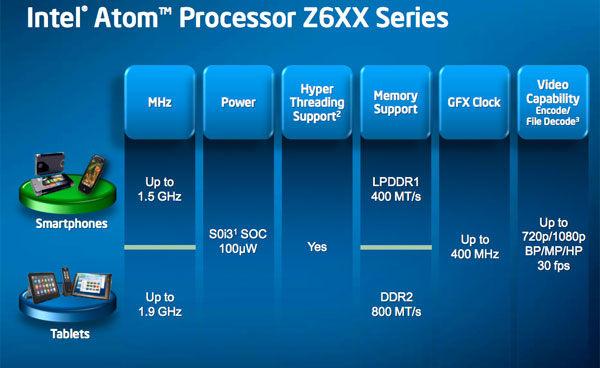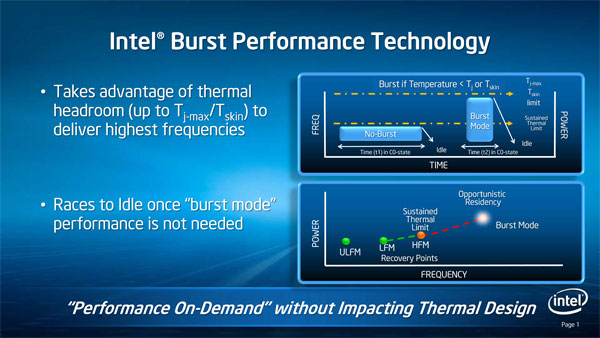Intel Unveils Moorestown and the Atom Z600, The Fastest Smartphone Platform?
by Anand Lal Shimpi on May 4, 2010 11:54 PM EST- Posted in
- Smartphones
- Intel
- Atom
- Mobile
- SoCs
Clock Speeds: 1.2GHz - 1.5GHz for Smartphones, 1.9GHz for Tablets
Intel isn't announcing individual Atom Z600 SKUs just yet, but we do know that all versions of the chip will support Hyper Threading (likely due to maintain a performance advantage compared to upcoming dual-core ARM offerings). There will be two versions of the Atom Z600 chips, one for smartphones and one for tablets.

The smartphone SKUs will run between 1.2GHz and 1.5GHz, while the tablet version of the Z600 will run at up to 1.9GHz.
Power Management: Clock Down or Turbo Up
Eleven years ago Intel demoed a technology it called Geyserville for mobile CPUs. The technology simply ran the CPU at a lower frequency when running on battery power and a higher frequency when plugged in. Intel eventually called this SpeedStep.
Four years later we got EIST, Enhanced Intel SpeedStep Technology. This allowed a mobile (and eventually desktop) CPU to run at any frequency depending on the performance demanded by the OS and the running applications.
On today’s Atom processors this usually means the chip will run as low as 600MHz when idle and at 133MHz increments all the way up to 1.66GHz under load. You don’t normally drop below 600MHz because that falls into the inefficient range of CPU performance scaling for a netbook/nettop. In a smartphone though, the majority of time your CPU isn’t being used. The SoC and accessory processors have enough custom logic offload a lot, even when your phone isn’t idle.
Lincroft, or the Atom Z600 series, supports even lower frequency modes. The CPU can clock itself down well below 600MHz.
When you need performance however Lincroft has something similar to Turbo Boost on Intel’s desktop CPUs. On the Atom Z600 series it’s called Burst Mode and unlike Turbo, it is more tightly integrated with the OS.

EIST and other dynamic clocking technologies rely on OS P-states to determine what frequency the chip should run at. If an OS requests P0, the CPU simply runs at its highest frequency.
On the Core i5 and i7, if the OS requests the CPU be in P0, then as long as the chip doesn’t violate any current or TDP limitations it will run at a higher turbo frequency instead of the default maximum clock speed the OS is requesting. P0 will always return the highest possible frequency given the thermal conditions of the chip.
The Atom Z600 doesn’t work like this. All potential burst mode frequencies are enumerated as P-states by the BIOS. An OS with proper support for Moorestown will be able to request any specific clock frequency, even burst frequencies. Loading a web page for example might result in the OS asking for the highest possible burst mode frequency, but while you’re reading the page the OS might request a slower P-state. The chip will run at whatever the OS requests, but it will exit burst mode if the chip’s temperature gets too high.
The FSB speed also scales with clock frequency. Once you reach a certain clock speed threshold, the Atom Z600 will automatically double its FSB frequency to help feed the CPU faster. The goal isn’t just to deliver peak performance, but it’s also to complete tasks faster so that the SoC can return to an idle state as soon as possible. The hurry up and go idle approach to mobile CPU performance has been one of Intel’s basic tenants for well over a decade now. And it does work. This is the reason we’ve generally seen an increase in battery life from each subsequent version of the Centrino platform.
The software management of burst mode puts more emphasis on the OS and platform vendors to properly tune their devices for the best balance of performance/power consumption. You can see why Wind River’s Android platform and Moblin are necessary to get the most out of Moorestown.










67 Comments
View All Comments
DanNeely - Wednesday, May 5, 2010 - link
I think you're misunderstanding the slide. It's not saying 1024x600 to 1366x768, it's saying upto 1366x768 on interface A, upto 1024x600 on interface B.Mike1111 - Wednesday, May 5, 2010 - link
Thanks for the clarification. Looks like I really misunderstood this sentence:"Lincroft only supports two display interfaces: 1024 x 600 over MIPI (lower power display interface) or 1366 x 768 over LVDS (for tablets/smartbooks/netbooks)."
uibo - Wednesday, May 5, 2010 - link
I wonder how many transistors are there in a Cortex A9 core? Just the core nothing else.For me it seems that ARM could just double or quadruple their core count against the Intel solution while still maintaining lower transistor count.
Also they could just increase the CPU clock speed, if there is a market for the more power-hungry Intel solution the there is one for the ARM also.
strikeback03 - Wednesday, May 5, 2010 - link
I would imagine even less smartphone software is written for multi-core now than was for desktop when dual-core CPUs started appearing in desktops. So going beyond 2 cores at this time is probably not a great move. Plus the dual core A9 isn't out to see power consumption yet, but even at 45nm I doubt it will be much below the current 65nm single-core chips if at all, so if Intel is already competitive then ARM doesn't exactly have the power budget to add cores.uibo - Thursday, May 6, 2010 - link
That actually makes sense. Nobody is going to write multi-threaded apps for a single thread CPU. I'd imagine that the number of apps, which experience is hindered by performance, is not that great at the moment. Games, browsers, UI, database for the info stored in your device - I'm not expecting these to scale perfectly across many cores but do expect a x0% performance increase.DanNeely - Thursday, May 6, 2010 - link
The real benefit for the 2nd core is probably multi-tasking. Your streaming music app can run in the background on the second core while your browser still has a full core to render web pages.Shadowmaster625 - Wednesday, May 5, 2010 - link
Mooresetown has to support a desktop OS. Intel is clearly moving towards wireless computing. They are bringing wireless video. With wireless video you can turn your phone into a desktop pc instantly by adding a wireless monitor and keyboard. What is the point of moving in that direction if you're moving towards a crippled OS? (Not that windows isnt crippled, if you consider obesity a form of cripple.)If it needs a pci bus, then emulate one!
Caddish - Wednesday, May 5, 2010 - link
Just registered to say keep up the good work. Since the SSD antology I have red all of your article like that one and they are awesomelegoman666 - Wednesday, May 5, 2010 - link
Excellent article, very well written.jasperjones - Wednesday, May 5, 2010 - link
Anand,You mention twice in the article that Apple and Google dominate the smartphone market. This is utter nonsense. The numbers from IDC as well as the numbers from Canalys clearly show that Nokia is the worldwide leader in the smartphone market. RIM is number 2. Apple is in the third place, the first company that produces Android devices, HTC, has the number 4 spot.
I realize that Nokia's market share in the U.S. is smaller than its global market share. However, even if we restrict ourselves to the U.S. market, RIM smartphone sales are bigger than those of Apple. They are also bigger than the sales of all Android smartphones combined.